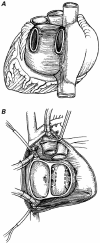The surgical anatomy of experimental and clinical thoracic organ transplantation
- PMID: 15061629
- PMCID: PMC387435
The surgical anatomy of experimental and clinical thoracic organ transplantation
Abstract
The experimental investigation of heart transplantation began almost 100 years ago, but it was not until the studies at Stanford Medical School in the late 1950s and early 1960s that clinical transplantation became a realistic possibility. Barnard performed the 1st human-to-human orthotopic heart transplantation in 1967 and followed this by introducing the technique of heterotopic heart transplantation in 1974. Reitz and colleagues at Stanford performed the 1st successful clinical transplantation of the heart and both lungs in 1981. Two years later, at the Toronto General Hospital, successful single-lung transplantation was performed, followed by bilateral lung transplantation in 1986. Aspects of the surgical techniques of these various experimental and clinical procedures are discussed.
Figures







Similar articles
-
The history of heart and heart-lung transplantation.Cardiovasc Clin. 1990;20(2):3-19. Cardiovasc Clin. 1990. PMID: 2404604
-
History of Lung and Heart-Lung Transplantation, With Special Emphasis on German-Speaking Countries.Transplant Proc. 2016 Oct;48(8):2779-2781. doi: 10.1016/j.transproceed.2016.07.015. Transplant Proc. 2016. PMID: 27788817
-
[French contribution to the progress of new surgical disciplines].Bull Acad Natl Med. 1996 Jan;180(1):13-31. Bull Acad Natl Med. 1996. PMID: 8696870 French. No abstract available.
-
Christiaan Barnard and his contributions to heart transplantation.J Heart Lung Transplant. 2001 Jun;20(6):599-610. doi: 10.1016/s1053-2498(00)00245-x. J Heart Lung Transplant. 2001. PMID: 11404164 Review.
-
Review of significant microvascular surgical breakthroughs involving the heart and lungs in rats.Microsurgery. 1999;19(2):71-7. doi: 10.1002/(sici)1098-2752(1999)19:2<71::aid-micr6>3.0.co;2-5. Microsurgery. 1999. PMID: 10188829 Review.
References
-
- Cooper DKC, Miller LW, Patterson GA. The transplantation and replacement of thoracic organs. The present status of biological and mechanical replacement of the heart and lungs. 2nd ed. Dordrecht: Kluwer Academic Publishers; 1996.
-
- Cass MH, Brock R. Heart excision and replacement. Guys Hosp Rep 1959;108:285–90. - PubMed
-
- Cooper DKC, Wicomb WN, Barnard CN. Storage of the donor heart by a portable hypothermic perfusion system: experimental development and clinical experience. Heart Transplant 1983;2:104–10.
-
- Barnard CN. The operation. A human cardiac transplant: an interim report of a successful operation performed at Groote Schuur Hospital, Cape Town. S Afr Med J 1967;41:1271–4. - PubMed
Publication types
MeSH terms
LinkOut - more resources
Full Text Sources
Medical
